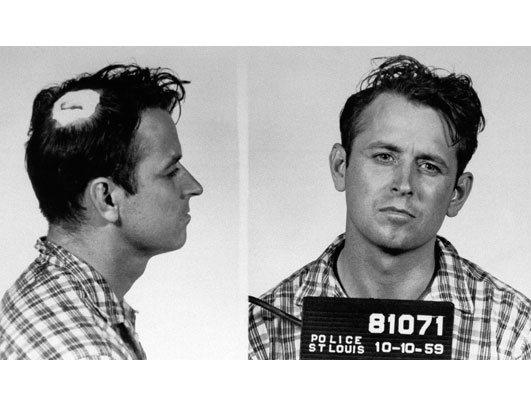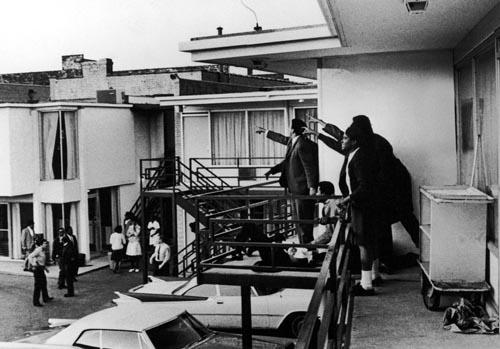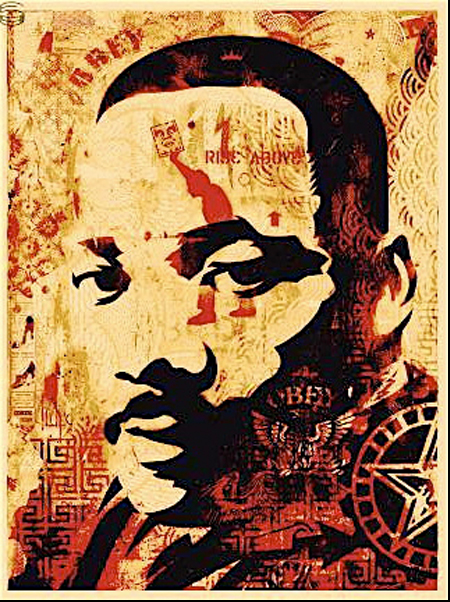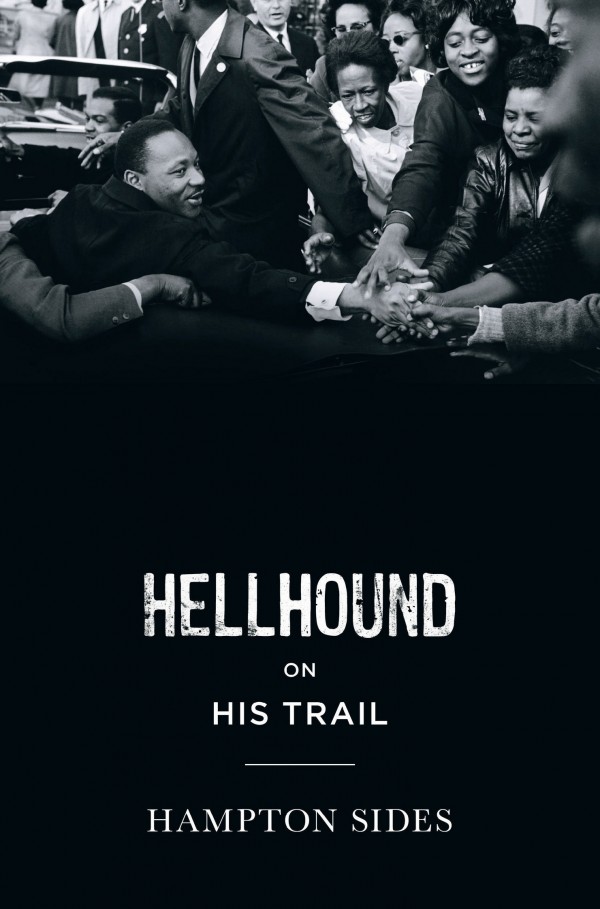Hampton Sides is an acclaimed bestselling author and a National Magazine Award nominated journalist. He won the PEN USA Award for nonfiction and the 2002 Discover Award from Barnes and Noble for Ghost Soldiers, a historical narrative following the rescue of WWII Bataan Death March survivors that was later adapted into the Miramax feature film The Great Raid. His next book, Blood and Thunder, was adapted into an episode of the Public Broadcasting Service’s American Experience series. Hellhound On His Trail, is a taut and thrilling account of the assassination of Martin Luther King, Jr., and the 65-day manhunt for his killer, the longest in American history.
PHAWKER: The book is called Hellhound On His Trail, which is a variation on the title of an old Robert Johnson song. Why did you choose that for the title?
HAMPTON SIDES: Memphis plays such a huge role in the book and in the life of Martin Luther King — it was were he came to recruit for his Poor People’s Campaign and it was where he was assassinated. And Memphis is Robert Johnson country, it’s blues country. The song is all about being pursued, either by fate or history or death, depending on how you read the song. It’s all about looking over your shoulder. The book is really about how the FBI is chasing King, and then Ray is chasing King, and then the book changes emotional valence when the FBI is chasing Ray. It’s meant to work on multiple levels.
PHAWKER: In broad strokes, can you explain James Earl Ray’s worldview, specifically as it applies to race.
HAMPTON SIDES: Well, he was a racist. He talked while he was in prison about how killing King would be his retirement plan. He called him Martin Luther Coon. He was contemplating moving to Rhodesia [after killing King], which was a racist/segregationist breakaway state that didn’t have an extradition treaty with the US. He was doing volunteer work for the George Wallace campaign in 1968. None of this necessarily explains why he would pick up a gun and stalk King and try to shoot him. There is some mental illness there, aggravated by long term use of amphetamines. And the idea that he had that he was going to be the ambitious one in his family, I think he did view this as a business proposition, because there were various bounties on King’s head, and I think he hoped that eventually he would collect one of them.
PHAWKER: But he was not a join-the-KKK kind of a racist…
HAMPTON SIDES: No, but he wasn’t a joiner period and he spent a good portion of his adult life behind bars anyway, so it would be hard for him to go to meetings of the local Klan. Also, once he was out he was a fugitive so he was reluctant to get too familiar with any group. And the volunteer work he did for the George Wallace campaign was done under an alias.
PHAWKER: For the benefit of our younger readers, could you explain the George Wallace phenomenon?
HAMPTON SIDES: George Wallace was the former governor of Alabama, who was quite articulate, in his redneck way, at articulating the frustrations of the white underclass. So when he ran for President in 1968 as an independent candidate he enjoyed an initial surge in popularity. It was the most successful independent campaign since Teddy Roosevelt’s Bull Moose party. Wallace was a stone cold racist, he was the guy who stood in the doorway at the University of Alabama to prevent integration. He was governor of the state where Martin Luther King enjoyed most of his Civil Rights victories —  Birmingham Alabama, Selma, Alabama — so there was a sense that MLK and Wallace sort of played off each other and I think that this was a duality that was going on in Ray’s mind.
Birmingham Alabama, Selma, Alabama — so there was a sense that MLK and Wallace sort of played off each other and I think that this was a duality that was going on in Ray’s mind.
PHAWKER: How would you compare the mindset of the average George Wallace supporter with the virulent anti-Obama sentiment of the Tea Party?
HAMPTON SIDES: The culture of hate is still alive and well. Only now it’s armed with technology, specifically the Internet, which has become sort of an echo chamber of hate. These people are out there. There is a lot of chatter, loose talk about taking on politicians and police men. People packing heat at political meetings. Talk about taking the country back, violently if necessary. It’s scary. So I think there is a lot of similarity. I guess Mark Twain was right when he said that history does not necessarily repeat itself, but sometimes it rhymes. And it’s rhyming right now in a lot of stark ways. Demagogues like George Wallace don’t always understand the effect that the poison they are putting out into the world effects certain people. Especially lost souls like James Earl Ray who will take the message literally and pick up a gun and change history.
PHAWKER: Speaking of which, there is a lot of veiled threats and intimations of violence being bandied about these days, not just on the Internet but on cable television. How would you compare this sort of siege mentality of today with America back in 1968?
HAMPTON SIDES: Well, I was six years old then. But my understanding that there was a lot of frustration, people feeling disenfranchised, people not liking the direction that society was going in. The John Birch Society was growing in popularity, you had these White Citizens’ Council everywhere, Wallace was the most obvious expression of it. There was a lot of anger and frustration and certain politicians exploited that for political gain, and you certainly have some of that going on today. I don’t want to implicate the entire Tea Part movement, because there certainly are some legitimate elements to it, but there is also a big lunatic fringe that is very similar to what was going on back in 1968: clinging to your guns, taking back the government. There is a lot of this kind of vaguely threatening chatter out there and I worry constantly about where it’s going to lead.
PHAWKER: For the benefit of our younger readers, could you explain the White Citizens’ Council. It was sort of racism cloaked in the legitimacy of the establishment, much more implied and tacit than, say, the blatant racism of the white supremacists, correct?
HAMPTON SIDES: Yeah, all over the South there were these groups. Mostly made of up prominent members of the community, Chamber of  Commerce types, and they would talk about the importance of preserving white culture and white institutions, they were against integration of public facilities and schools. They weren’t rabid in their message, they tried to come across as reasonable, but really they were the public relations arm of the Klan.
Commerce types, and they would talk about the importance of preserving white culture and white institutions, they were against integration of public facilities and schools. They weren’t rabid in their message, they tried to come across as reasonable, but really they were the public relations arm of the Klan.
PHAWKER: One of Ray’s schemes for getting rich after he escaped from prison was to become a porn mogul. How come that never really went anywhere?
HAMPTON SIDES: Unclear. He did buy a bunch of camera equipment, with the hopes of becoming a porn director or a cameraman. He was certain there was a lot of money to be made in it, but as was typical with a lot of things in Ray’s life, he would get very excited about something and then fail to connect the dots and follow-through and make it happen. But he did all kinds of things when he was living in LA: he took dancing lessons, he went to bartending school figuring it would be a useful skill once he went abroad after the assassination, he took a correspondence course in locksmithing, he studied hypnosis. He even got a nose job shortly before the assassination. So he dabbled in all sorts of thing, very eclectic interests. It’s hard to figure out what they all add up to other than he was a desperately unhappy person trying to find some kind of meaning in his life. These are the kinds of people that the Wallace movement could prey on. It gave these sort of people a sense of purpose.
PHAWKER: Can you clarify the incident right after King was shot in which Jesse Jackson, one of his aides at the time, wiped his hands in King’s blood and wiped it on his shirt?
HAMPTON SIDES: Jackson was the youngest member of King’s entourage, he was 25 years old. And after King was assassinated, he stepped forward and stood in front of the cameras and began to spin a fiction which was that he was the last person that King spoke too, that he was cradling King in his arms when he died and that this blood on his shirt — which he wore to numerous interviews, for days after the assassination — was a martyr’s blood, the implication being that Jackson was the natural heir to King’s legacy. When in fact it was Ralph Abernathy, King’s best friend, who was with him on the balcony that Jackson imagined for himself. Needless to say it caused a huge amount of consternation and anger within King’s inner circle.
PHAWKER: One of the strangest things about the assassination, to my mind, is that there were these — I don’t know if they were FBI or Memphis police officers — in a fire station across from the Lorraine Motel watching the whole thing go down.
HAMPTON SIDES: There was a fire station right across from the Lorraine, it’s still there, and in the basement were these undercover Memphis cops  that had been spying on King’s group all through the day and several days before that. I spoke to one of them and he said that they were there not so much to spy on King himself but to figure out what his relationship was with a black power group in Memphis known as The Invaders, who were largely blamed for starting the violence at the protest march on behalf of the striking Memphis sanitation workers that went down a week prior to King’s assassination. They were negotiating with King’s people and the police wanted to know if King had extracted a promise from the Black Invaders not to cause violence in the next march. There was a lot of coming and going, people meeting in various rooms of the Lorraine. The cops were watching all this through a window covered up with newspaper, except for a tiny spy hole, when the heard the shot ring out. So yeah, there were cops watching all of it go down.
that had been spying on King’s group all through the day and several days before that. I spoke to one of them and he said that they were there not so much to spy on King himself but to figure out what his relationship was with a black power group in Memphis known as The Invaders, who were largely blamed for starting the violence at the protest march on behalf of the striking Memphis sanitation workers that went down a week prior to King’s assassination. They were negotiating with King’s people and the police wanted to know if King had extracted a promise from the Black Invaders not to cause violence in the next march. There was a lot of coming and going, people meeting in various rooms of the Lorraine. The cops were watching all this through a window covered up with newspaper, except for a tiny spy hole, when the heard the shot ring out. So yeah, there were cops watching all of it go down.
PHAWKER: And yet, the final conclusion you arrive at in the book is that there was no grand conspiracy to kill King.
HAMPTON SIDES: It’s human nature to look for a larger pattern at work in a crime like this, especially when you consider J. Edgar Hoover and the FBI at the time, and the role that he played in trying to ruin King and ruin his movement, sending his field agents all over the country to spy on King, to smear him and sabotage the Civil Rights movement. So it is reasonable to assume there was some larger conspiracy, but in the end I could find no evidence of one, at least not the sophisticated, shadowy conspiracy we all imagine. A crude one? Yes. I believe Ray had some help along the way, I think members of his family probably knew about it. During his fugitive wanderings he had meetings with people and it’s not really clear what went on in those meetings. But Ray admitted that he bought the scope and the ammo and the gun and checked into that hotel and that he jumped into the getaway car afterwards, and when he was first arrested, he admitted that he pulled the trigger. But he recanted a few days later and said that he had done all those other things he said he did, but he didn’t pull the trigger, that was this other guy named ‘Raul’. Well, who is Raul? We don’t have a last name, a picture of him, where he lived, what nationality he was. That’s because I think he was just made up by Ray, just another alias, sort of James Earl Ray’s imaginary friend. But the nation was so receptive to the notion of a conspiracy at the time that even just the mention of the name Raul set off all these spider webs of intrigue in the popular imagination. And you had members of King’s family that believed in Raul, and members of the inner circle who think there was something to this Raul thing, but there is not a shred of evidence that he ever existed.
[As told to JONATHAN VALANIA]
ROBERT JOHNSON: Hellhound On My Trail

